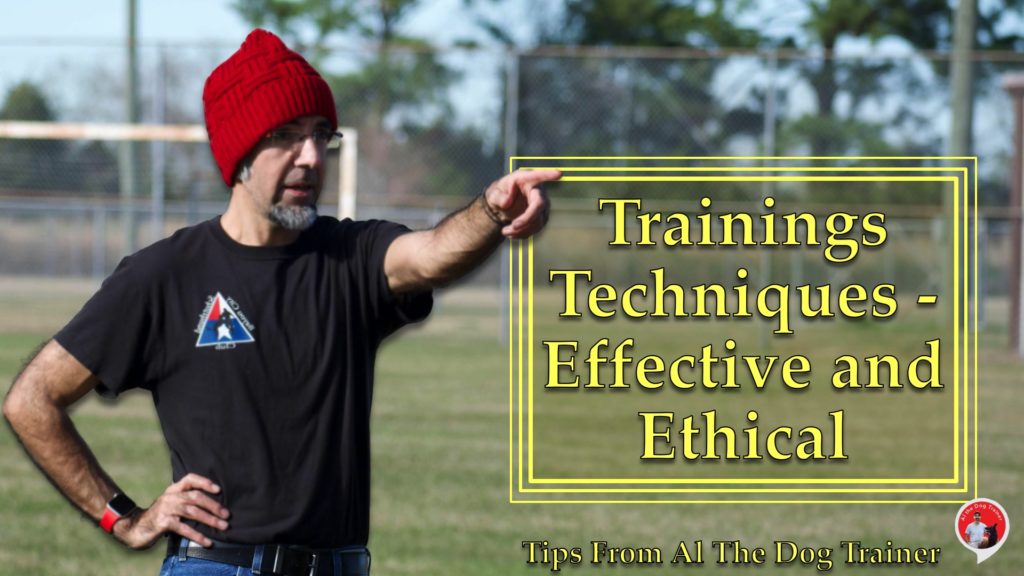
Today’s topic is trainings techniques – effective and ethical. There are quite a few ways to go about training dogs, and there are many different labels that are out there. You probably have heard of rewards-based. You’ve probably heard traditional training. Maybe you’ve heard purely positive. There’s balance training, avoidance training, pressure training, and even clicker training. I could keep going on and on.
There are many different techniques and methodologies for training dogs, and I think it’s important to understand that there are also ethics involved.
Don’t Do Anything Unethical
Many people don’t want to do things that are considered unethical, and I happen to agree with them. You definitely don’t want to do unethical things with any of your more powerful tools. Like the remote collar, prong collars, or any collar. Even some types of harnesses. It’s possible that you could injure your dog.
Now, injury is not the only unethical thing, in my opinion. Accidents do happen. Dogs do get injured from time to time, just on their own. And so obviously, an accident is something that you’re not actually causing the dog to do.
I like talking about these challenging types of things when it comes to effectiveness and ethics. Let me share an example that I talk about all the time. I think it is worth sharing and then talking about if this is something you should do. So let’s say you decide to put your hand on a hot stove as a human. At that moment that you put your hand on the hot stove, you’re going to feel pain. It’s going to damage and injure your hand. Now, the question is, are you going to repeat that?
Well, the chances of repeating that, if you’re a normal human being, is not very likely. You’re not probably going to repeat it because it was painful. It made you uncomfortable. And your brain said putting your hand on the stove is a bad thing. So there, you can see that the pain is effective. But is that effective and ethical?
Would that be ethical to use that as a way to teach somebody not to touch the stove? Obviously not. I don’t think that you should ever do something like that. It doesn’t mean that it doesn’t work. It just means that there are probably better ways to go about teaching a human being something.
So for me, personally, I don’t ever think that we should use any technique that’s going to injure a dog. Now, I’m quite alright making a dog uncomfortable. I’m also alright with making a dog frustrated to a degree, but I don’t think that we need to be using actual pain or things that create injuries to train dogs.
Is My Dog Uncomfortable?
So let me share another circumstance with you. Let’s say that your dog is wearing a buckle collar and you are struggling with your dog to get them to walk on a leash. So you clip your leash onto the dog’s collar, and you attempt to go out for a walk. Your dog is pulling you the entire time, and you can hear your dog gasping for air from all the tension that’s coming down the leash to the collar, but the dog continues to pull anyway.
So a question that I have is… If you went out for that kind of walk, you did that for 10-15 minutes. Where your dog is dragging you, and you can hear them gagging against the leash. A good question to ask yourself is, is my dog actually uncomfortable? It’s my opinion that if your dog is walking for that long, gagging against the leash, they are not.
Now, there’s some bad news here because your dog is not actually uncomfortable here. Are you eventually going to injure them? If you continue to do this? Yes, you are. You’re going to injure your dog. The bad thing is that your dog has such a high tolerance that the injury may be hidden for some while. It could cause some severe problems down the road.
Effective And Ethical
Now, let me give you another scenario. Let’s say that you go out and buy yourself a Herm Springer prong collar, the three-millimeter variety. You then place it on your dog, and you put the dog on a six-foot leash. Then you walk out the door, and you’ve got the dog on a nice short leash. And then, all of a sudden, your dog bolts out, you lose a little bit of the leash, and the dog runs at the end of the leash and then yelps because the collar them. So that way, they don’t overwhelm themselves through the collar.
Now, for the record, I’m not too fond of that. But if your dog goes out to the end of the line and yelps because the collar did that to them and they became uncomfortable, is it likely that they’re going to continue to pull? Probably not. And so wouldn’t that be a better choice, even though the dog did become uncomfortable for a moment, this is something really worth pondering.
I wanted to share this with you today because I want us to think about being effective yet ethical. And how not to be effective and create pain and injury without being too soft with their dogs and avoiding tools that could help us.
Professional Help
This is why getting involved with a professional dog trainer is essential because of the experience that people like myself tend to have with the proper use of many different tools, not just a lot of different tools. We can help you. We can help guide you to make the best decision for your specific dog.
I think this tip is really just a way to give some perspective about how to look at the dog training, make decisions that work well for the dog. Being effective and ethical.
Now, the last thing that I’ll say there, you should be rewarding your dog at a very high rate with the things that they enjoy the most the vast majority of the time. And using any of the tools that I’ve mentioned today to correct your dog should not be done without a serious look at how to actually reward them well for what you want them to do. Because if you’re using tools, they create discomfort to set up smart boundaries for your dog. And there’s no reward then; in my opinion, that’s ethical.
I hope this was helpful to you in some way. Please remember you can always visit my YouTube Channel for more tips or find them right here on my website www.longoriahausdogtraining.com.
Happy Training!





